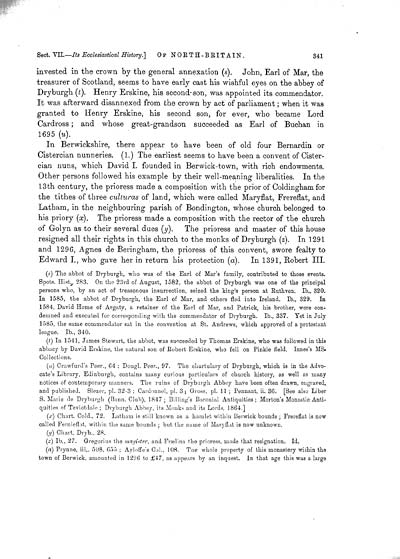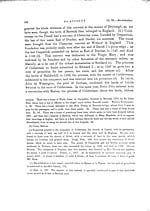Volume 3
(353) Page 341
Download files
Individual page:
Thumbnail gallery: Grid view | List view

341 invested in the crown by the general annexation (*). John, Earl of Mar, the treasurer of Scotland, seems to have early cast his wishful eyes on the ahbey of Dryburgh (t). Henry Erskine, his second son, was appointed its commendator. It was afterward disannexed from the crown by act of parliament; when it was granted to Henry Erskine, his second son, for ever, who became Lord Cardross; and whose great-grandson succeeded as Earl of Buchan in 1695 (w). In Berwickshire, there appear to have been of old four Bernardin or Cistercian nunneries. (1.) The earliest seems to have been a convent of Cister- cian nuns, which David I. founded in Berwick-town, with rich endowments. Other persons followed his example by their well-meaning liberalities. In the 13th century, the prioress made a composition with the prior of Coldingham for the tithes of three culturas of land, which were called Maryflat, Frereflat, and Latham, in the neighbouring parish of Bondington, whose church belonged to his priory (x). The prioress made a composition with the rector of the church of Golyn as to their several dues (y). The prioress and master of this house resigned all their rights in this church to the monks of Dryburgh (z). In 1291 and 1296, Agnes de Beringham, the prioress of this convent, swore fealty to Edward I., who gave her in return his protection (a). In 1391, Robert III. (.s-) The abbot of Dryburgh, who was of the Earl of Mar's family, contributed to those events. Spots. Hist., 283. On the 23rd of August, 1582, the abbot of Dryburgh was one of the principal persons who, by an act of treasonous insurrection, seized the king's person at Ruthven. Ib., 320. In 1585, the abbot of Dryburgh, the Earl of Mar, and others fled into Ireland. Ib., 329. In 1584, David Home of Argaty, a retainer of the Earl of Mar, and Patrick, his brother, were con- demned and executed for corresponding with the commendator of Dryburgh. Ib., 337. Yet in July 1585, the same commendator sat in the convention at St. Andrews, which approved of a protestant league. Ib., 340. (t) In 1541, James Stewart, the abbot, was succeeded by Thomas Erskine, who was followed in this abbacy by David Erskine, the natural son of Robert Erskine, who fell on Pinkie field. Innes's MS. Collections. (it) Crawfurd's Peer., 64 ; Dougl. Peer., 97. The chartulary of Dryburgh, which is in the Advo- cate's Library, Edinburgh, contains many curious particulars of church history, as well as many notices of contemporary manners. The ruins of Dryburgh Abbey have been often drawn, engraved, and published. Slezer, pl,. 32-3 ; Cardrmnel, pl. 3; Grose, pl. 11 ; Pennant, ii. 36. [See also Liber S. Marie de Dryburgh (Bann. Club), 1847; Billing's Baronial Antiquities; Morton's Monastic Anti- quities of Teviotdale ; Dryburgh Abbey, its Monks and its Lords, 1864.] (x) Chart. Cold., 72. Latham is still known as a hamlet within Berwick bounds ; Frereflat is now called Ferniefl'it, within the same bounds ; but the name of Maryflat is now unknown. (y) Chart. Dryb., 28. (z) Ib., 27. Gregorius the majister, and Fraslina the prioress, made that resignation. Id. (a) Prynne, Hi., 508, 65") ; Ayloffe's Cal., 108. The whole property of this monastery within the town of Berwick, amounted in 1206 to �47, as appears by an inquest. In that age this was a large
Set display mode to:
![]() Universal Viewer |
Universal Viewer | ![]() Mirador |
Large image | Transcription
Mirador |
Large image | Transcription
Images and transcriptions on this page, including medium image downloads, may be used under the Creative Commons Attribution 4.0 International Licence unless otherwise stated. ![]()
| Caledonia, or, An account, historical and topographic of North Britain from the most ancient to the present times > Volume 3 > (353) Page 341 |
|---|
| Permanent URL | https://digital.nls.uk/74528780 |
|---|---|
| Description | Vol. III. |
|---|---|
| Attribution and copyright: |
|

